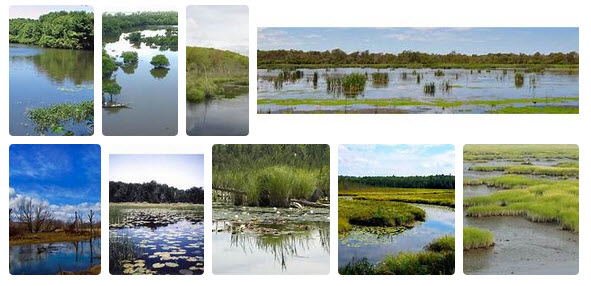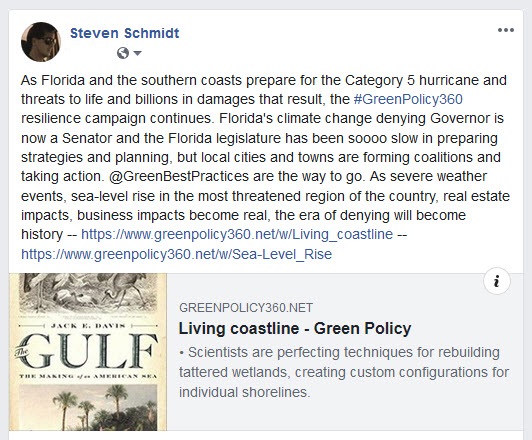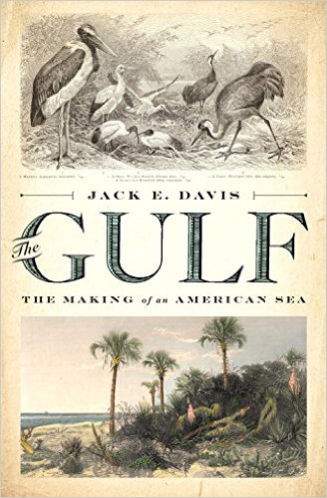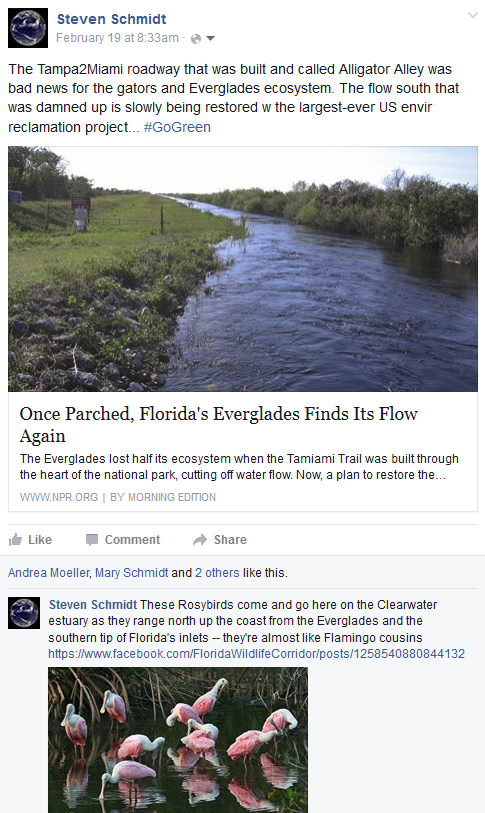Living coastline
Living Shorelines & Natural Defenses
GreenPolicy360: Living Coastlines, Living Shorelines campaign
Rebuilt Wetlands Can Protect Shorelines Better Than Walls
• https://www.greenpolicy360.net/w/File:Against_the_Tide_by_Cornelia_Dean.jpg
Coastal mangroves are an effective and resilient defense against sea-level rise, extreme weather events, storm surge and flooding
Researchers have provided high-resolution estimates of the economic value of mangrove forests for flood risk reduction across more than 700,000 kilometers of coastlines worldwide... engineering and economic models provide the best analyses of coastal flood risk and mangrove benefits... when, where, and how mangroves reduce flooding, and they identified innovative ways to fund mangrove protection using economic incentives, insurance, and climate risk financing.
"Now that we can value these flood protection benefits, it opens all kinds of new opportunities to fund mangrove conservation and restoration with savings for insurance premiums, storm rebuilding, climate adaptation, and community development," said Mangrove study coauthor Michael Beck, research professor in the Institute of Marine Sciences at UC Santa Cruz.
How do mangroves protect against wave action and storm surge? (vid)
Via Scientific American
• Surprising data show that in many places marshes protect shorelines better than walls and are cheaper to construct.
• Scientists are perfecting techniques for rebuilding tattered wetlands, creating custom configurations for individual shorelines.
• Governments and disaster planners are starting to give more consideration to living shorelines, and money to restore them is rising.
···················································································
"The 'living shoreline' is the best defense against sea-level rise."
-- Jack E. Davis, author of "The Gulf: The Making of An American Sea"
Florida, one of the lowest lying and most vulnerable states in the United States, begins to seriously look at sea-level rise.
Southeast Florida, Advancing Resilience Solutions Through Regional Action
• Southeast Florida Regional Compact Climate Change
• Report: 40 percent of Florida property will be ‘highly exposed’ to flooding
One of Florida’s biggest draws is also one if its biggest liabilities — its coastline. A new report projects that Florida is at the greatest risk of any state for tidal flooding caused by rising sea levels. And Tampa Bay faces some of the greatest risk within the Sunshine State.
According to a report by the Union of Concerned Scientists, nearly 40 percent of the state’s property tax base is expected to be "highly exposed" to such flooding within the next 30 years.
• Within 20 years, by 2035, nearly 170 coastal US communities — roughly twice as many as today — will reach or exceed the threshold for chronic inundation, given moderate sea level rise. Seventy percent of these will be in Louisiana and Maryland, where land subsidence is contributing to rapid rates of sea level rise. More than half of these 170 communities are currently home to socioeconomically vulnerable neighborhoods.
• Within 45 years, by 2060, more than 270 coastal US communities — including many that seldom or never experience tidal flooding today — will be chronically inundated, given moderate sea level rise.
• By the end of the century, given moderate sea level rise, nearly 490 communities — including 40 percent of all East and Gulf Coast oceanfront communities — will be chronically inundated.
• Given more rapid sea level rise, nearly 670 coastal US communities will face chronic inundation by the end of the century. This number includes nearly 60 percent of East and Gulf Coast oceanfront communities as well as a small but growing number of West Coast communities.
• Worldwide, the impacts of climate change and sea-level rise will produce profound challenges and test whether humanity is capable of organizing cooperatively to acknowledge, face and confront global environmental change across borders and nations.
Mangrove Forests for the Future / Via World Economic Forum
•https://www.weforum.org/agenda/2019/02/5-reasons-to-protect-mangrove-forests-for-the-future/
We are destroying a coastal ecosystem that helps sustain life and livelihoods. Here are five of the many reasons we should be doing much more to preserve mangrove forests.
1. They are a natural coastal defence
The sturdy root systems of mangrove trees help form a natural barrier against violent storm surges and floods. River and land sediment is trapped by the roots, which protects coastline areas and slows erosion. This filtering process also prevents harmful sediment reaching coral reefs and seagrass meadows.
In 2017, the UN Ocean Conference estimated that nearly 2.4 billion people live within 100 km of the coast. Mangroves provide valuable protection for communities at risk from sea-level rises and severe weather events caused by climate change.
2. They are carbon sinks
Coastal forests help the fight against global warming by removing carbon dioxide from the atmosphere, most of which is stored within the plant. When mangrove tree roots, branches and leaves die they are usually covered by soil, which is then submerged under tidal water, slowing the breakdown of materials and boosting carbon storage.
Research shows that coastal mangroves outperform most other forests in their capacity to store carbon. An examination of 25 mangrove forests across the Indo-Pacific region found that per hectare, they held up to four times more carbon than other tropical rainforests.
3. They provide livelihoods
Many people living in and around mangroves depend on them for their livelihood. The trees are a reliable source of wood for construction and fuel, which is prized for its hardy resistance to both rot and insects. However, in some areas, the wood has been harvested commercially for pulp, wood chip and charcoal, raising concerns about sustainability.
Plant extracts are collected by locals for their medicinal qualities and the leaves of mangrove trees are often used for animal fodder.
The forest waters provide local fishermen with a rich supply of fish, crabs and shellfish to sell for income.
4. They encourage ecotourism
Sustainable tourism offers a stimulus to preserve existing mangrove areas, with potential to generate income for local inhabitants.
Often located near to coral reefs and sandy beaches, the forests provide a rich environment for activities like sports fishing, kayaking and birdwatching tours.
Of course, it is important to maintain a balance between visitor numbers and protecting the forests’ delicate ecosystem.
If held at sustainable levels, ecotourism could provide the perfect motivation to protect mangroves, instead of clearing them for mass tourism developments.
5. They are rich in biodiversity
Human activity has caused huge biodiversity loss in land and marine ecosystems around the globe, endangering many plant and animal species.
By filtering coastal waters, mangroves form a nutrient-rich breeding ground for numerous species that thrive above and below the waterline.
A huge variety of wildlife lives or breeds in the mangrove ecosystem, including numerous fish, crab and shrimp species, molluscs, and mammals like sea turtles. The trees are home to an array of nesting, breeding and migratory birds. When mangrove forests are cleared valuable habitat is lost, threatening the survival of myriad species.
But that’s not the whole story. The forests are also a potential source of undiscovered biological materials that could benefit mankind, such as antibacterial compounds and pest-resistant genes, which are also lost when coastal areas are cleared.
Land clearance of mangrove areas and other forests like the Amazon has had a major impact on different species. The International Union for Conservation of Nature’s (IUCN) Red List shows that of 68,574 species of invertebrates, 8,374 were on the brink of extinction.
Protecting natural ecosystems like mangrove forests not only helps preserve biodiversity, it also helps preserve a vital resource for local communities.
It is essential to control invasive species that are damaging mangrove forests and coastal ecosystems, most expansively the Brazilian Pepper Tree in Florida, Gulf and Southern Coastal Regions
Brazilian Pepper Management Plan for Florida
Brazilian pepper is a pioneer of disturbed sites such as highway, canal and powerline rights-of-way,fallow fields, and drained cypress stands, but it is also successful in many undisturbed natural environments (Woodall, 1982). Brazilian pepper successfully colonizes many native plant communities, including pine flatwoods, tropical hardwood hammocks, and mangrove forest (Loope and Dunevitz 1981, Ewel, et al., 1982, Woodall 1982). The invasion of this aggressive, woody weed poses a serious threat to species diversity in many of Florida’s native ecosystems, and is eliminating many indigenous sources of food for wildlife (Morton, 1979). In 1969, biologists at Everglades National Park were expressing, with alarming concern, that Brazilian pepper had the potential to destroy many of South Florida’s natural areas (Morton, 1979). Brazilian pepper now covers hundreds of thousands of acres in south and central Florida, as well as many of the islands on the east and west coasts of the state (Bennett and Habeck, 1991). Biannual exotics surveys conducted by the South Florida Water Management District indicate that Brazilian pepper is the most widespread exotic plant in the state - occupying more than 700,000 acres.
More on preservation/conservation of biodiversity at https://www.greenpolicy360.net/w/File:IPBES-assessment_stages-a.jpg
More on resilience planning and green best practices https://www.greenpolicy360.net/w/Resilience -- https://www.greenpolicy360.net/w/Category:Green_Best_Practices
More on sea-level rise at https://www.greenpolicy360.net/w/Sea-Level_Rise
···················································································
(Excerpt from GreenPolicy360/Sea-level Rise, June 2019)
Prep Now for Storm Surge, Flooding, Sea-level Rise
GreenPolicy360 initiates "Living Coastline, Living Shoreline Resilience" campaign
Over the years, we have encouraged many ideas that have proven over time to provide effective solutions and "green best practices". In Florida for example, the terrestrial home base of GreenPolicy360, we have focused on the work of Jack E. Davis, author of the Pulitzer prize-winning book, The Gulf, and his sage advice:
"The 'living shoreline' is the best defense against sea-level rise."
-- Jack E. Davis, author of "The Gulf: The Making of An American Sea
Design principals of #resilience
GreenPolicy360 and green best practices, case studies and models, we're about making a positive difference. Sea-level rise is a threatening challenge and we are beginning to prepare NOW.
The recent visit to Florida by Dutch engineering ambassador, Henk Ovink, provides many solutions to Florida with its highly vulnerable coastal geography and porous limestone geology. Perhaps a "Think like the Dutch" motto, given the country's centuries of below sea-level experience, should be a beginning of a statewide education campaign. Although some politicians continue attempting to deny the reality, Florida is on the frontlines of global climate change and the cost of denial is, in a harsh reality, unacceptable.
○
California is a global leader in environmental initiatives, with many front-of-market solutions that are models designed for forward-looking communities. In alignment with GreenPolicy360's "Living Coastline, Living Shoreline Resilience" campaign, the San Francisco Bay areas living levee is a case study in smart planning.
Green Infrastructure for Rising Sea Levels - The Oro Loma Project
It’s time we “start to think of our natural systems as this incredibly valuable technology,” according to Letitia Grenier, a conservation biologist who directs the Resilient Landscapes Program at the nonprofit San Francisco Estuary Institute. She says vegetation can be a better flood barrier than hard infrastructure.
Natural infrastructure, effective, resilient, smart...
• https://youtu.be/Ecj81mkD-cA
·······················
Sea Walls?
Florida could face $76 billion in climate change costs by 2040, report says
The Center for Climate Integrity
"It is not just seawalls that should or are being considered as part of an effective sea level rise strategy"
At What Point Managed Retreat? Resilience Building in the Coastal Zone
• https://twitter.com/search?q=%23ManagedRetreatCU2019&src=typd
• http://www.climatecosts2040.org/
·········································
The Dutch Have Solutions to Rising Seas. The World Is Watching.
Preparing now for profound change and the coming storm is more than smart planning -- preparing now is critical to protecting and preserving life as we know it.
Southern Florida: A Case Study
- Best Practices
- Biodiversity
- City Governments
- City-County Governments
- Climate Change
- Climate Policy
- Citizen Science
- County Governments
- Earth Science
- Ecology Studies
- Ecoregions
- Environmental Protection
- Environmental Security
- Florida
- Global Warming
- Green Best Practices
- Green Politics
- Land Use
- Natural Resources
- Oceans
- Permaculture
- Planet Citizens, Planet Scientists
- Resilience
- Sea-level Rise
- Sea-Level Rise & Mitigation
- Strategic Demands
- Sustainability
- Sustainability Policies
- US Environmental Protection Agency
- Wetlands



